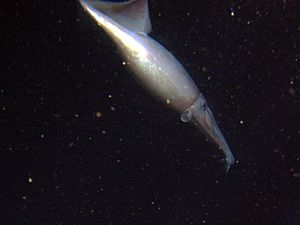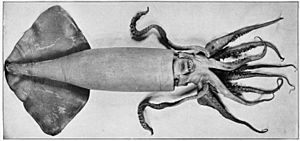Humboldt squid facts for kids
Quick facts for kids Humboldt squid |
|
|---|---|
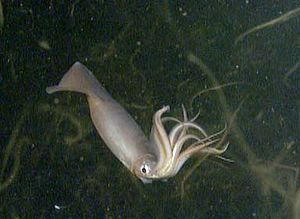 |
|
| A Humboldt squid swarms around ROV Tiburon, possibly attracted to its lights | |
| Conservation status | |
| Scientific classification | |
| Synonyms | |
|
The Humboldt squid (Dosidicus gigas) is also called the jumbo squid or red devil. It is a large squid that hunts other animals. It lives in the eastern Pacific Ocean, especially in the waters of the Humboldt Current.
These squids can grow quite big, with their main body (called the mantle) reaching about 1.5 m (4 ft 11 in) long. They are known for being aggressive, especially when they are hunting for food.
Humboldt squids can make their bodies glow and change colors very quickly. They flash red and white when they are hunting, which is why fishermen call them diablo rojo (Spanish for "red devil"). These color changes happen so fast that human eyes can barely see them. They have a short life, usually living only 1 to 2 years.
You can usually find them deep in the ocean, between 200 to 700 m (660 to 2,300 ft) down. They live from the southern tip of South America (Tierra del Fuego) all the way up to California. Recently, they have been moving further north into places like Oregon, Washington, British Columbia, and Alaska. People catch them for food, mostly in Mexico and Peru.
Contents
What does the Humboldt squid look like?
The Humboldt squid is the biggest type of Ommastrephid squid. Some can grow up to 2.5 m (8 ft 2 in) long and weigh as much as 50 kg (100 lb).
Their body, or mantle, makes up about 40% of their weight. Their fins, which act like wings, are about 12%. Their arms and tentacles are about 14%. Their eyes and beak are part of their head, which is about 5% of their weight. The rest is made up of their inner organs.
Humboldt squid behavior
Humboldt squids are meat-eaters that live in large groups called shoals. These groups can have up to 1,200 squids! They can swim very fast, up to 24 km/h (15 mph; 13 kn). They move by shooting water out of a special tube called a siphon and by using their two triangle-shaped fins.
Their tentacles have 100 to 200 suckers, and each sucker has sharp teeth. They use these to grab their prey and pull it towards their strong, sharp beak.
While Humboldt squids are known for being aggressive, especially when they are eating, they are usually calm at other times. They even eat other squids in their own group, especially if they are hurt. This might help them grow so quickly. Some scientists think they only attack humans if they see shiny diving gear or flashing lights. Divers who have swum with them say they seem more curious than mean when they are not feeding.
Humboldt squids move up and down in the water each day. They come closer to the surface from evening until morning. They usually live for about one year, but some bigger ones can live for up to two years.
Scientists used special cameras on two Humboldt squids. They found that the squids "flash talk" to each other by changing colors. They can also change their color patterns to hide. We don't know exactly what they are saying to each other yet!
Recent videos show that these squids can be aggressive towards new things. They have attacked deep-sea cameras, making them stop working. They also seem to be attracted to the lights of underwater vehicles. Some divers have reported being attacked by Humboldt squids. One diver, Scott Cassell, even made special body armor to protect himself.
Where do Humboldt squids live?
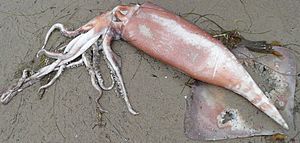
The Humboldt squid lives in the eastern Pacific Ocean. They are found at depths of 200 to 700 m (660 to 2,300 ft). Their home range goes from Tierra del Fuego in the south up to California. They are named after the Humboldt Current, a cold ocean current where they live.
Recently, these squids have been seen further north, even in British Columbia and Puget Sound. Sometimes, many squids wash up on beaches. This happened in Washington in 2004 and in Monterey Bay in 2012. Scientists think red algae might have caused some of these events.
Humboldt squid ecology
Humboldt squids mainly eat small fish, crustaceans (like crabs and shrimp), other cephalopods (like smaller squids), and tiny sea creatures called copepods.
They use their barbed suckers to grab prey. Then, they use their sharp beak and a special tongue-like tool called a radula to cut and tear the prey's flesh. They often rush at their prey with all ten arms and tentacles stretched out. When they get close, they open their eight arms and shoot out two long tentacles. These tentacles are covered in sharp "teeth" and grab the prey, pulling it back to their beak. This beak can cause serious cuts to human skin. The two long tentacles can grab prey and pull it back so fast that it's hard to see on video.
Another way they hunt is by pulling their prey very deep into the ocean until it passes out. Humboldt squids are also known to quickly eat larger prey when they hunt in groups. For a long time, people weren't sure if they hunted together. But research from 2007 to 2011 showed that they do hunt cooperatively.
Scientists believe that the Humboldt squid's recent move north along the U.S. West Coast might be because there are fewer big predators that would normally compete with them for food.
Humboldt squid reproduction
Female Humboldt squids lay clear, jelly-like egg masses that float in the water. The size of the egg mass depends on the size of the female squid. Large females can lay egg masses up to 3-4 meters wide! Smaller females lay masses about 1 meter wide.
It's rare for humans to find these egg masses, so we don't know much about them. But the few found so far have contained anywhere from 5,000 to over 4 million eggs.
Fishing for Humboldt squid
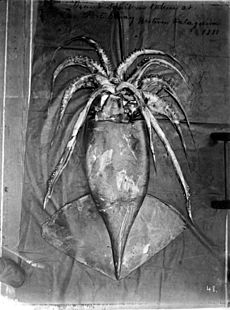
Squid as taken at Port Otway, western Patagonia, 1888
|
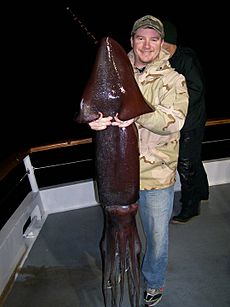
A 24-kilogram (52 lb) specimen caught off the southern Californian coast displays deep-red chromatophoric coloring.
|
People catch Humboldt squids to sell them around the world. They are popular in Europe (like Spain, Italy, and France), Russia, China, Japan, and Southeast Asia. More and more, they are also sold in North and South America.
Fishermen usually catch squid at night. They use bright lights on their boats. These lights attract tiny sea creatures called plankton, which then attract the squid to the surface to feed. Since the 1990s, the most squid have been caught in Chile, Mexico, and Peru.
Humboldt squids are known for quickly eating hooked fish, sharks, and even other squids from their own group. There are many stories of these squids attacking fishermen and divers. Their red and white flashing colors and aggressive behavior have earned them the nickname diablos rojos (red devils) from fishermen in Mexico.
Changes in where they live
Humboldt squids usually live in the warm Pacific waters near Mexico. But in the early 2000s, studies showed they started moving further north. After a big El Niño event in 1997–1998, Humboldt squids were seen in Monterey Bay for the first time. They came back in bigger numbers during a smaller El Niño in 2002 and have been there all year round since then.
Similar changes have been seen off the coasts of Washington, Oregon, and even Alaska. Scientists think warmer waters from El Niño events might be causing this. But other things, like fewer big predators that compete for food, could also be making them move.
Humboldt squid and ocean changes
A study in 2008 suggested that by the end of this century, ocean acidification (when the ocean becomes more acidic) could make Humboldt squids less active. This might force them to live in shallower waters where they can get more oxygen.
However, a more recent study suggests that ocean acidification might not affect squid as much as once thought.
Humboldt squid in popular media
The Humboldt squid has appeared in many TV shows and books.
In 2009, the squid was shown in the last episode of the BBC show Last Chance to See. The hosts talked to fishermen about the growing number of "red devils" in the Sea of Cortez and stories of them attacking people. They even showed a squid trying to bite a protected arm.
A group of Humboldt squids are the main bad guys in the 2013 book Below by Ryan Lockwood. They also appear in the 2015 book Strands of Sorrow by John Ringo.
In 2016, the Humboldt squid was featured in three TV shows. Man Eating Super Squid: A Monster Invasion on National Geographic Wild called the squid a "real-life kraken" and a "global threat."
In River Monsters: Devil of the Deep, TV host Jeremy Wade investigated attacks on fishermen in the Sea of Cortez. He found that Humboldt squids were the attackers and had moved south to Peru. Jeremy then caught several Humboldt squids off the coast of Peru.
On the British TV show Fishing Impossible in 2016, a team tried to catch a Humboldt squid by hand. They wore special diving suits with chain mail to protect themselves, but bad weather stopped them from diving.
Also in 2016, Humboldt squids were shown on BBC Earth's Blue Planet II. This show captured footage of their cannibalistic pack hunting for the very first time.
A Humboldt Squid is the only bad guy in the 2016 movie Finding Dory. It chases and tries to eat the main characters. This squid is shown as much bigger than real ones, easily destroying a shipping container.
In another film, fishermen talked about a fisherman being caught by a squid in the deep ocean. Another fisherman said a squid bit his skull, breaking it.
Images for kids
See also
 In Spanish: Potón del Pacífico o Calamar de Humboldt para niños
In Spanish: Potón del Pacífico o Calamar de Humboldt para niños



